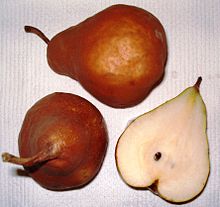Bosc's bottle pear
'Boscs bottle pear' (synonyms: often 'Kaiser Alexander', and more rarely 'Calebasse Bosc', 'Kaiserbirne', 'Alexanderbirne' and in Northern Germany 'Kaiserkrone' ) is an old pear variety .
history
The origin of the variety is unclear. Either it was bred by the Belgian pear grower Jean-Baptiste van Mons around 1807 and came from him to Adrian Diel in 1810 , or it is a chance seedling that was found as a tree near Apremont in 1793 .
Bosc's bottle pear was named after Louis Augustin Guillaume Bosc and Hadrian Diel referred to it as Emperor Alexander , probably after Alexander I. In the 1920s, Bosc's bottle pear was one of the three pear varieties that were chosen as imperial fruit varieties .
description
tree
The medium fast growing tree is as Standard tree and bush tree less suitable and forms - without care or education - a wide pyramidal treetop with vertical Leittrieben and horizontal side shoots off.
fruit
The fruit is medium to large with a height of 9–11 cm and a diameter of 5–7 cm, and is pear- to club- or cup-shaped. The rough skin has a greenish-yellow basic color, which is mostly completely rusty yellow-brown. The fine flesh is yellowish, sweet and sour and juicy with a fine aroma.
The fruit is used as a table pear or for boiling and is ripe for picking from the middle to the end of September / October and is then ready to be enjoyed - if it has a short shelf life.
Others
The Boscs bottle pear variety is easily confused with Princess Marianne - including the use of synonyms. Compared to this, the stem is shorter and connects to the fruit without a bulge.
See also
literature
- Manfred Fischer (Ed.): Color Atlas of Fruit Types. 2nd, heavily revised edition. Ulmer, Stuttgart 2003, ISBN 3-8001-5547-8 .
- Walter Hartmann (Ed.): Color Atlas of Old Fruit Types. 2nd, heavily revised edition. Ulmer, Stuttgart 2003, ISBN 3-8001-4394-1 .
Web links
- Illustration in Germany's fruit varieties.
- Bosc's bottle pear. Autumn pear at arche-noah.at (PDF; 266 kB)
- Bosc's bottle pear at baumgartner-baumschulen.de
- Index card of the variety in the BUND-Lemgo fruit variety database
